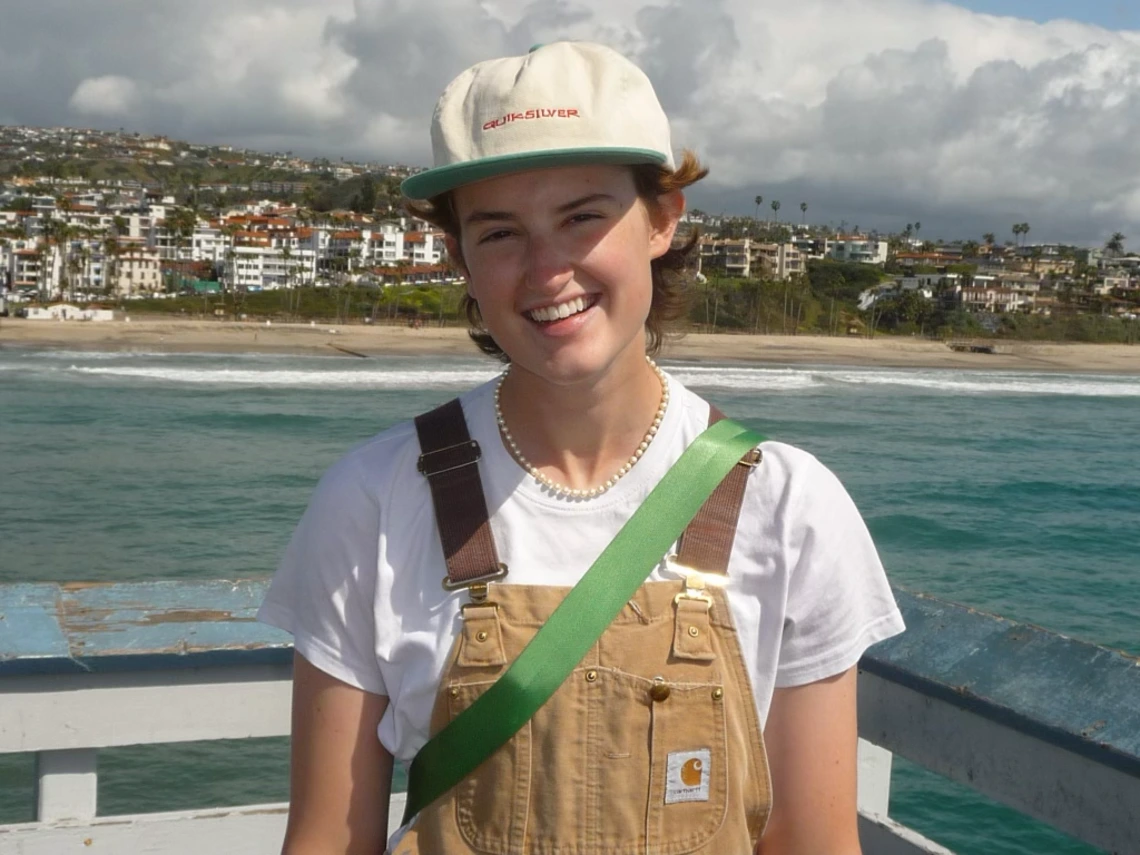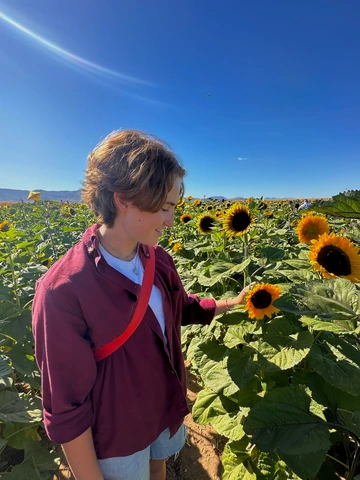Sawyer Sullivan: Inspiring Sustainability through Storytelling

Sawyer Sullivan is a sophomore studying neuroscience and cognitive science with minors in studio art and Spanish. With a focus on intersections between art, science, people and nature, Sullivan hopes to better understand how storytelling can inspire investment in the environment and shape decision making.
In this Q&A, Sullivan describes how she integrates neuroscience into her environmental involvement, shares her advice for finding community outside a major, and explores how incorporating perspectives across fields can contribute to envisioning a brighter future.
How have you been involved in environmental or other activities as a student at the University of Arizona?
I am a part of the Hydrocats Committee in the Students for Sustainability club on campus. We work on a lot of water-based sustainability projects around campus and the surrounding community. Additionally, my Earth Grant internship has allowed me to get more involved within the environmental space both on campus, as well as in the Tucson community. I am also a tutor at the Writing Center and find that it’s a lot of fun to engage with students on all sorts of writing.
How do you hope to incorporate environmental or sustainability values into your future career goals?
With my neuroscience degree, I’m interested in studying the interactions between humans and their environment, as well as epigenetics – the ways in which the environment can impact gene expression.
I’m always looking for intersections between art and science, between people and nature. I’m fascinated by decision making, and I enjoy finding ways to use art and stories to impact someone’s decisions and enact change. I want to learn more about what triggers emotional responses in people, as art is one of the ways to inspire people to care about the environment.
Through stories and visual arts, people can be moved to change their ways of thinking or living. I want to look at that intersection between neuroscience and art and use it when thinking about sustainable design.
Wherever my degree takes me, whether that be research, clinical work, or more community-focused engagement, I hope to incorporate sustainability into my own decisions and to use what I learn about human behavior to impact the decisions of others.
"The environment impacts our lives far more than solely the world that we exist on; it is embedded within our ways of thinking, the choices we make, and how we interact and connect with one another. Caring about it means caring about each other." - Sawyer Sullivan
Where have you found community while at the University of Arizona, particularly in terms of connecting with students who are also interested in the environment?
Since what I’m studying is not in the environmental field, it is important to find ways outside of classes to meet like-minded people and be able to work on projects related to sustainability.
Students for Sustainability has allowed me to not only find that community within the university, but also in the greater Tucson community. From teaching elementary students about the water table, to building a pollinator garden at a local high school, to ripping out invasive plants in Saguaro National Park, there have been so many ways to stay involved. Being a part of this club has introduced me to incredible people who have the same passion for sustainability and the environment as I do, and it helps me connect with and learn from them.
Additionally, my internship through AIR’s Earth Grant program has connected me to other students who are interested in environmentalism and working in the community. The nonprofit that I am working with, Sonoran Institute, has put on many events such as Santa Cruz River cleanups and a dragonfly BioBlitz, where I’ve met both other community members as well as other students who are interested in the environment and conservation.

What advice do you have for other students with similar interests, especially in terms of finding opportunities “outside of the classroom” to get involved with?
A lot of the opportunities that I’ve been lucky enough to experience have come from those communities that I joined. Specifically, the Students for Sustainability club provides many opportunities to work in the surrounding areas, as well as projects on campus.
There is always something going on, something to do, and something to work on. It’s a matter of deciding what sorts of things you want to focus on, and what areas interest you. For instance, I really wanted to get involved with hands-on projects: digging irrigation, removing buffelgrass, planting native species. However, if you are someone who is more interested in the outreach and education side of things, there are opportunities for that as well.
Through this club as well as my internship, I’ve been able to meet some incredible people with fascinating and important stories. Going to events, both as a participant and a leader, has led me to some amazing conversations with professors, local business owners, community leaders, neighbors, and other students.
The best advice I could give would be to jump at any opportunity to go out and meet people and participate in something that you are passionate about. Saying yes to events that I saw in emails, on websites, or at my club meetings has helped me meet new people, build connections, and gain close friends.
Why should students care about the environment, even if it isn't their major or area of study?
There are environmental impacts for most of the decisions we make, so regardless of your area of study, there is most likely an intersection with sustainability and the environment. Being conscious of how those decisions impact our futures both environmentally and socioculturally is necessary when thinking about conservation.
"It’s easy to gloss over art and stories and view those as tangential to what really moves and changes the world; often we view science and technology as doing the heavy work of progress. But humanity only moves forward when a group of people see a common goal to struggle towards, and art and stories are incredibly powerful ways to bring people together. That emotional connection can be the first step towards coalition and ultimately towards sparking change." - Sawyer Sullivan
My work with Sonoran Institute is heavily focused on people; protecting our rivers means protecting the waterways that feed multiple states, countries, and native lands. The implications behind the policies we make and the research and science that we explore impact communities that may not have voices in those areas.
It’s important to consider the humans who exist in the environments we are studying–not only their impact on the environment, but the impact our research might have on them, and the ways in which we can make space for their voices in policies. Bringing other fields of study to the conversation is necessary to understand the history as well as envision a future that is beneficial to both the environment and the community.
The environment impacts our lives far more than solely the world that we exist on; it is embedded within our ways of thinking, the choices we make, and how we interact and connect with one another. Caring about it means caring about each other.
How do you think utilizing diverse fields (such as art and neuroscience) can help enhance people’s connection to their natural environment?
There is a lot of power in looking at the intersectionality and combination of various interests and ideas. My love for art and neuroscience and my passion for the environment has allowed me to connect with others in important ways.
I’m interested in how individuals make decisions and how the context of their lives – the people, cultures, stories, environment, and even art – influence those decisions.
It’s easy to gloss over art and stories and view those as tangential to what really moves and changes the world; often we view science and technology as doing the heavy work of progress. But humanity only moves forward when a group of people see a common goal to struggle towards. And art and stories are incredibly powerful ways to bring people together. That emotional connection can be the first step towards coalition and ultimately towards sparking change.
Being conscious of the story you are writing and the narrative you are telling can have an incredible impact on others and can bring about beneficial connections and change for all of us. Connecting diverse fields with environmental science can spark conversations, moving us towards progress and a welcoming, cooperative space within the environmental fields.
